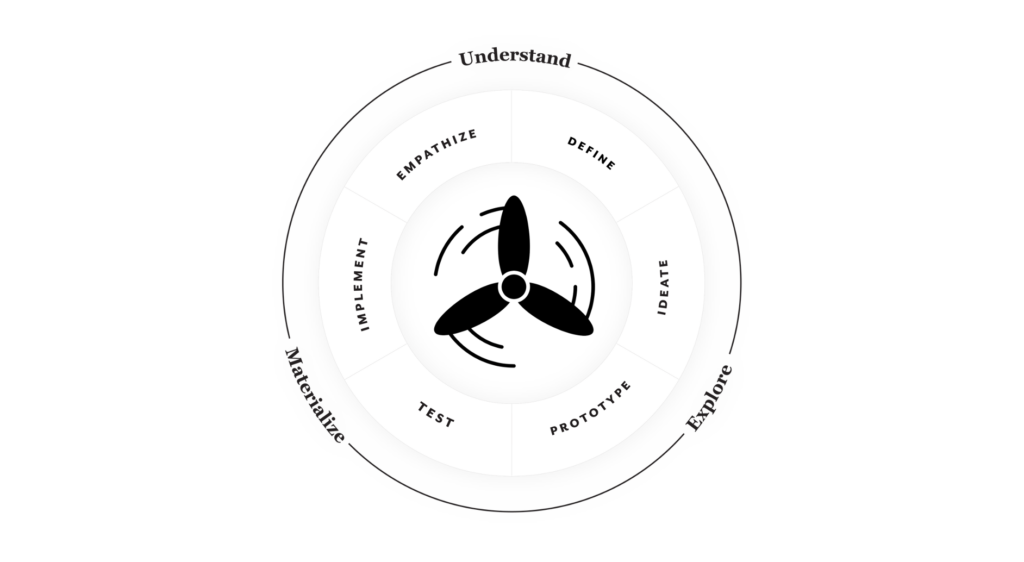I’m a little late to writing out my Defense of Design Thinking, I know. What can I say? Late-stage capitalism has been capitalizing my time.
I recently ran a class teaching Design Thinking basics to the Product Development team, with a mixture of Product, Development, QE, and UXers taking part. While we all work on software, outside of the Product team and UX team, not a lot of these folks have ever really been exposed to Design Thinking, so it was fascinating to see everyone pick up and run with some of the mindset that it propels. To keep the interest of the group I was teaching, I explained the six stages of the circle, and after each dialogue on the stage, we’d do a quick exercise to put the philosophy into practice.
When I introduce Design Thinking to folks who aren’t familiar with the methodology, I make a point of using a pop culture persona, polling the attendees before the session to see what media property they all had at least a baseline knowledge of – this session we did Marvel Superheroes, so I got to pull out an ad-hoc persona of Clint Barton, AKA Hawkeye as he hit on multiple routes to work on solving his problems.

Why do I use pop culture and media properties? Simple. I’ve found out the hard way that if I use anything within the industry, the attendees focus on the work and lose the reason behind what they’re learning about. Using something outside of the industry they’re in seems to help everyone retain the philosophy better from what I’ve found.
I’ve been teaching a flavor of this class for almost a decade, always tweaking and changing things as I learn and grow myself, and I get a little warm and fuzzy when I get to introduce it to folks who haven’t seen it in practice before.
Design Thinking has gotten such a bad rap over the last few years, and it took me a while to wrap my head around what they took offense to. It’s been a boon to help me out through my career. Then it hit me.
Y’all, we’re doing Design Thinking wrong.
We have to stop treating it like a process – it’s a methodology at worst and a mindset at best. It’s a big toolbox that contains almost infinite tools at your disposal to get into the muck and mess that is getting to the heart of your users’ problems and trying to find the best solution for those problems. It’s not there to be followed diligently outside of the scaffolding that the overall stages provide. If you hit the Cornerstone Principles, you’ve accomplished it.

That’s it. No need to have to run anything else that you’ve been taught is immutable and unchangeable. It’s a way of looking at the gnarly problems that your company has been made to help solve for your customers and clients.
Is it a cure-all? Hell no. If your company doesn’t do the work in researching and understanding your clients and customers, it’s all just a little bit of theater instead of doing its job to help point you in the right direction. When you dig into a lot of these posts and articles that decry that IDEO or anyone else selling Design Thinking is full of it, in this case? I completely agree. You have to know your users to be able to make Design Thinking successful. You’re working off of assumptions until you get to testing usually, which means your assumptions better be based on fact, otherwise, why are you even trying to build something?
I teach using Design Thinking theater because folks do retain it, but when I’m using it for our initiative work, it’s steeped in the research that the team has done, and the knowledge of the industry and your users is integral to taking full advantage of methodology.
If you dig a little deeper into most of the articles that I’ve linked throughout, they’re saying the same thing as this post that I’m writing now. It’s not that Design Thinking is dead, useless, or a waste of your team’s time… it’s the fact that we’ve all been doing it incorrectly. Remember that what we’re doing is organizing chaos at the end of the day, to make things work for our users.
This is, though, just my opinion. Design Thinking is something that I use to help change hearts and minds daily for most of my career. Am I alone in this?

